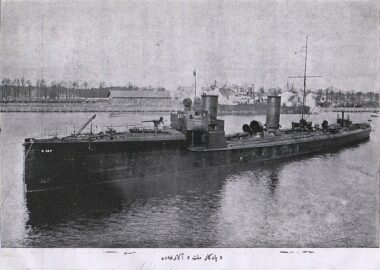| Type | Destroyer | Hull | Steel |
| Displacement | 765 tonnes | Engines | 2 turbines, 17.700shp, Schichau |
| Length | 74.0 m | Machinery | Steam turbines, 2 schafts |
| Beam | 7.9 m | Speed | 9 kts |
| Draught | 3.0 m | Complement | 3 officers, 81 enlisted men |
| Armament | 2 × 75 mm (3 in) guns | 2 × 57 mm (2.2 in) guns | 3 × 45 cm (17.7 in) torpedo tubes | ||
 The journey of Yadigar-ı Millet یادکار ملت began in 1908 when it was laid down at the Schichau-Werke in Elbing, Germany, under the name S166, a S138-class torpedo boat. However, during its fitting out, it was acquired by the Ottoman Navy, and renamed Yadigar-ı Millet, signifying “Gift of the Nation”, as the purchase was made through donations channeled by the Ottoman Navy Association.
The journey of Yadigar-ı Millet یادکار ملت began in 1908 when it was laid down at the Schichau-Werke in Elbing, Germany, under the name S166, a S138-class torpedo boat. However, during its fitting out, it was acquired by the Ottoman Navy, and renamed Yadigar-ı Millet, signifying “Gift of the Nation”, as the purchase was made through donations channeled by the Ottoman Navy Association.
Alongside three sister ships - Muavenet-i Milliye, Numune-i Hamiyet, and Gayret-i Vataniye - Yadigar-ı Millet joined the Ottoman fleet in March 1910, coinciding with the acquisition of two pre-dreadnought battleships, Barbaros Hayreddin and Turgut Reis. This strategic move bolstered the Ottoman Navy's capabilities and signalled the ship's active role in the years to come.
The Italo-Turkish War of 1911 saw Yadigar-ı Millet assigned to the main destroyer flotilla, commencing a period of naval engagement. Despite the initial confusion surrounding the outbreak of war, the Ottoman fleet, including Yadigar-ı Millet, sought refuge behind coastal fortifications at the Dardanelles, leading to minimal interaction with the Italian fleet.
It was during the First Balkan War in late 1912 and early 1913 that Yadigar-ı Millet truly came into her own. Positioned in the Bosphorus Fleet alongside other modern Ottoman naval units, the ship embarked on a series of raids along the Bulgarian Black Sea coast. These daring endeavours included attacks on Bulgarian artillery batteries near Varna, showcasing the ship's combat prowess.
In December 1913, the ship became part of I Division, tasked with various naval operations. One notable event was the Battle of Elli on 16 December, where Yadigar-ı Millet and her fellow ships played a crucial role in screening the Ottoman battleship division. Though this engagement failed to produce significant results, it marked another chapter in the ship's wartime service.
As the First Balkan War progressed, Yadigar-ı Millet continued its patrols and encounters with Greek forces, reflecting the dynamic and ever-evolving nature of naval warfare during this period.
The First World War ushered in a new era for the ship as it became part of I Destroyer Squadron, serving alongside its sister ships. It took part in various operations, including carrying a contingent of Germans back to Germany after their ship, the protected cruiser Emden, was sunk. On June 29, 1915, she engaged the British submarine E14 west of Island of Marmara. A torpedo was fired but it was a miss.
Yadigar-ı Millet met its fate in a dramatic fashion on July 10, 1917, when it fell victim to a British Royal Naval Air Service bombing raid while moored alongside Yavuz at Istinye docks in Istanbul. This incident made Yadigar-ı Millet the largest ship sunk by air during the First World War. The ship was later refloated and drydocked. In December 1918, she was moored in Istanbul and later sunk. Yadigar-ı Millet was scrapped in 1924.
![]()





